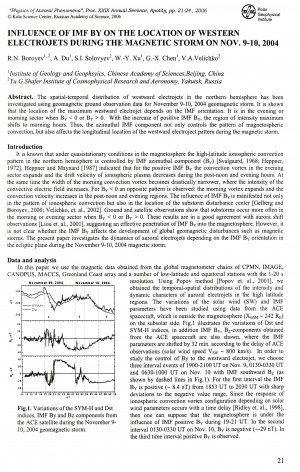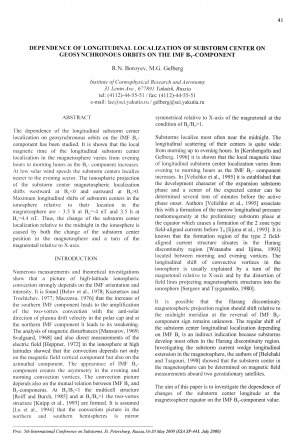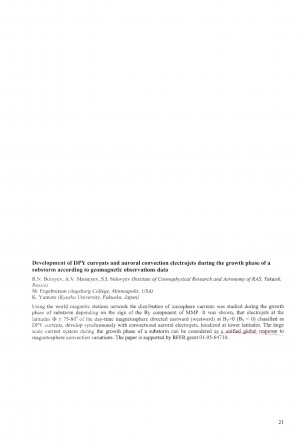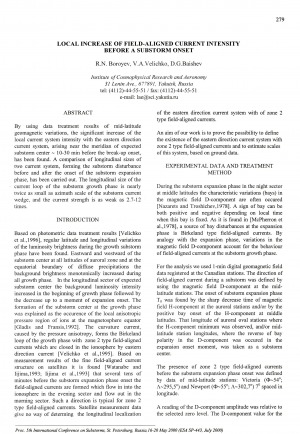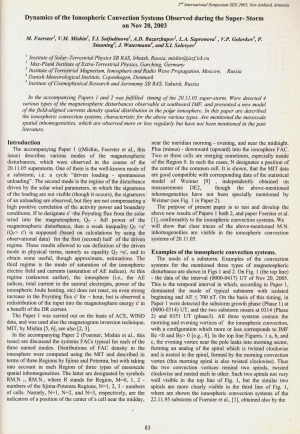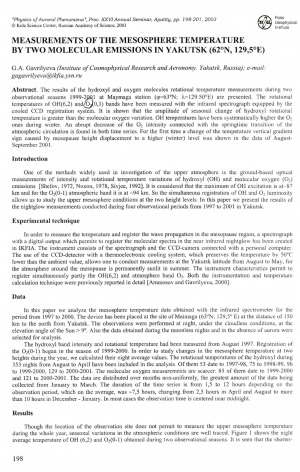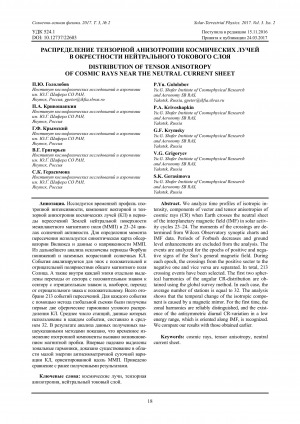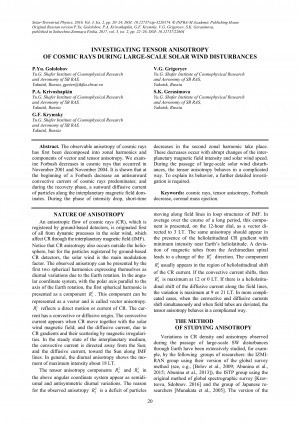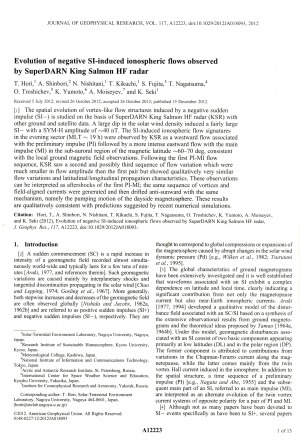Количество страниц: 4 с.
Influence of IMF by on the location of western electrojets during the magnetic storm on Nov. 9-10, 2004 / R. N. Boroev, A. Du, S. I. Solovyev, W.-Y. Xu, G.-X. Chen, V. A. Velichko // Physics of auroral phenomena : proceedings of the 29th annual seminar, Apatity, 27 February–3 March 2006. – 2007. – P. 21-24.
Количество страниц: 4 с.
Boroyev, R. N. Dependence of longitudinal localization of substorm center on geosynchronous orbits on the IMF Bγ-component / R. N. Boroyev, M. G. Gelberg // Proceedings of the Fifth International Conference on Substorms : 16-20 May 2000 Congress Centre of the Arctic and Antarctic Research Institute, St. Petersburg, Russia. − Noordwijk, Netherlands : European Space Agency, 2000. − P. 41-44.
Количество страниц: 2 с.
Development of DPY currents and auroral convection electrojets during the growth phase of a substorm accocding to geomagnetic observations data : [тезисы докладов] / R. N. Boroev, A. V. Moiseyev, S. I. Solovyev, M. Engebretson, K. Yumoto // Physics of auroral phenomena : 26th annual seminar, 25-28 February 2003 : abstacts. – 2003. – P. 21.
Количество страниц: 4 с.
Boroyev, R. N. Local increase of field-aligned current intensity before a substorm onset / R. N. Boroyev, V. A. Velichko, D. G. Baishev // Proceedings of the Fifth International Conference on Substorms : 16-20 May 2000 Congress Centre of the Arctic and Antarctic Research Institute, St. Petersburg, Russia. − Noordwijk, Netherlands : European Space Agency, 2000. − P. 279-282.
Количество страниц: 3 с.
- Математика. Естественные науки > Астрономия. Астрофизика. Исследование космического пространства. Геодезия,
- Математика. Естественные науки > Геология. Геологические и геофизические науки,
- Прикладные науки. Медицина. Ветеринария. Техника. Сельское хозяйство > Инженерное дело. Техника в целом,
- НАУКА ЯКУТИИ > МАТЕМАТИКА. ЕСТЕСТВЕННЫЕ НАУКИ > Астрономия. Астрофизика. Исследование космического пространства. Геодезия,
- НАУКА ЯКУТИИ > ПРИКЛАДНЫЕ НАУКИ. МЕДИЦИНА. ТЕХНИКА. СЕЛЬСКОЕ ХОЗЯЙСТВО > Инженерное дело. Техника в целом,
- НАУКА ЯКУТИИ > МАТЕМАТИКА. ЕСТЕСТВЕННЫЕ НАУКИ > Геология. Геологические и геофизические науки.
Dynamics of the Ionospheric Convection Systems Observed during The Super-Storm on Nov. 20, 2003 / M. Foerster, V. M. Mishin, T. I. Saifudinova, A. D. Bazarzhapov, L. A. Sapronova, V. P. Golovkov, P. Stauning, J. Watermann, and S. I. Solovyev // Solar Extreme Events Fundamental Science and Applied Aspects Nor-Amberd, Armenia 26-30 September 2005 : proceedings of the Second International Symposium / edited by A. Chilingarian and G. Karapetyan. − Erevan : Cosmic Ray Division, Alikhanyan Physics Institute, 2006. − P. 83-85.
Количество страниц: 4 с.
Gavrilyeva, G. A. Measurements of the mesosphere temperature by two molecular emissions in Yakutsk (62°N, 129,5°E) / G. A. Gavrilyeva // Physics of auroral phenomena : proceedings of the 26th annual seminar, 25 - 28 February 2003. – 2003. – P. 198-201.
Количество страниц: 4 с.
Gololobov, A. Yu. Modeling the influence of magnetospheric heat fluxes on the electron temperature in the subauroral ionosphere = Моделирование влияния магнитосферных потоков тепла на температуру электронов в субавроральной ионосфере / A. Yu. Gololobov, I. A. Golikov, I. I. Varlamov // Солнечно-земная физика = Solar-Terrestrial Physics. – 2017. – Т. 3, N 2 : 13-я российско-китайская конференция по космической погоде. – С. 54-57. – DOI: 10.12737/22595.
DOI: 10.12737/22595
Количество страниц: 4 с.
We analyze time profiles of isotropic intensity, components of vector and tensor anisotropies of cosmic rays (CR) when Earth crosses the neutral sheet of the interplanetary magnetic field (IMF) in solar activity cycles 23-24. The moments of the crossings are determined from Wilcox Observatory synoptic charts and IMF data. Periods of Forbush decreases and ground level enhancements are excluded from the analysis. The events are analyzed for the epochs of positive and negative signs of the Sun’s general magnetic field. During each epoch, the crossings from the positive sector to the negative one and vice versa are separated. In total, 213 crossing events have been selected. The first two spherical harmonics of the angular CR-distribution are obtained using the global survey method. In each case, the average number of stations is equal to 32. The analysis shows that the temporal change of the isotropic component is caused by a magnetic mirror. For the first time, the zonal harmonics are reliably distinguished, and the existence of the antisymmetric diurnal CR-variation in a low energy range, which is oriented along IMF, is recognized. We compare our results with those obtained earlier.
Distribution of tensor anisotropy of cosmic rays near the neutral current sheet = Распределение тензорной анизотропии космических лучей в окрестности токового слоя / P. Yu. Gololobov, P. A. Krivoshapkin, G. F. Krymsky, V.G. Grigoryev, S. K. Gerasimova // Солнечно-земная физика = Solar-Terrestrial Physics. – 2017, т. 3, N 2 : 13-я российско-китайская конференция по космической погоде. – С. 18-21.
DOI: 10.12737/22603
Количество страниц: 5 с.
The observable anisotropy of cosmic rays has first been decomposed into zonal harmonics and components of vector and tensor anisotropy. We examine Forbush decreases in cosmic rays that occurred in November 2001 and November 2004. It is shown that at the beginning of a Forbush decrease an antisunward convective current of cosmic rays predominates; and during the recovery phase, a sunward diffusive current of particles along the interplanetary magnetic field dominates. During the phase of intensity drop, short-time decreases in the second zonal harmonic take place. These decreases occur with abrupt changes of the interplanetary magnetic field intensity and solar wind speed. During the passage of large-scale solar wind disturbances, the tensor anisotropy behaves in a complicated way. To explain its behavior, a further detailed investigation is required.
Investigating tensor anisotropy of cosmic rays during large-scale solar wind disturbances = Исследование тензорной анизотропии космических лучей во время крупномасштабных возмущений солнечного ветра / P. Yu. Gololobov, P. A. Krivoshapkin, G. F. Krymsky, V. G. Grigoryev, S. K. Gerasimova // Солнечно-земная физика = Solar-Terrestrial Physics. – 2017, т. 3, N 2 : 13-я российско-китайская конференция по космической погоде. – С. 22-26.
DOI: 10.12737/22604
Количество страниц: 14 с.
Evolution of negative SI-induced ionospheric flows observed by SuperDARN King Salmon HF radar / T. Hori, A. Shinbori, N. Nishitani, T. Kikuchi, S. Fujita, T. Nagatsuma, O. Troshichev, K. Yumoto, A. Moiseyev, and K. Seki // Journal of Geophysical Research: Space Physics. – 1978. – 2012 (December), vol. 117, N 12. – P. A12223.
DOI: 10.1029/2012JA018093
